Lille had a tough task to face Paris Saint-Germain at home in fixture 21 of Ligue 1 last Sunday.
Christophe Galtier’s side have suffered a dip in form, losing two games in a row prior to facing Paris Saint-Germain. Morale was low, but they knew they needed to bounce back as soon as possible.
Paris Saint-Germain, on the flip side, have been unbeaten since fixture 13 in Ligue 1. Thomas Tuchel’s side came into the game with high confidence and vigour. PSG clearly seemed to be the more motivated and confident side in the game.
After this 0-2 loss at home against PSG, Lille have dropped down the table and currently sit seventh in the Ligue 1 table. Meanwhile, PSG remain the table-toppers.
In this tactical analysis, we’ll examine both teams’ tactics and see how Neymar and co. managed to bring home three points from Stade Pierre-Mauroy last Sunday.
Lineups
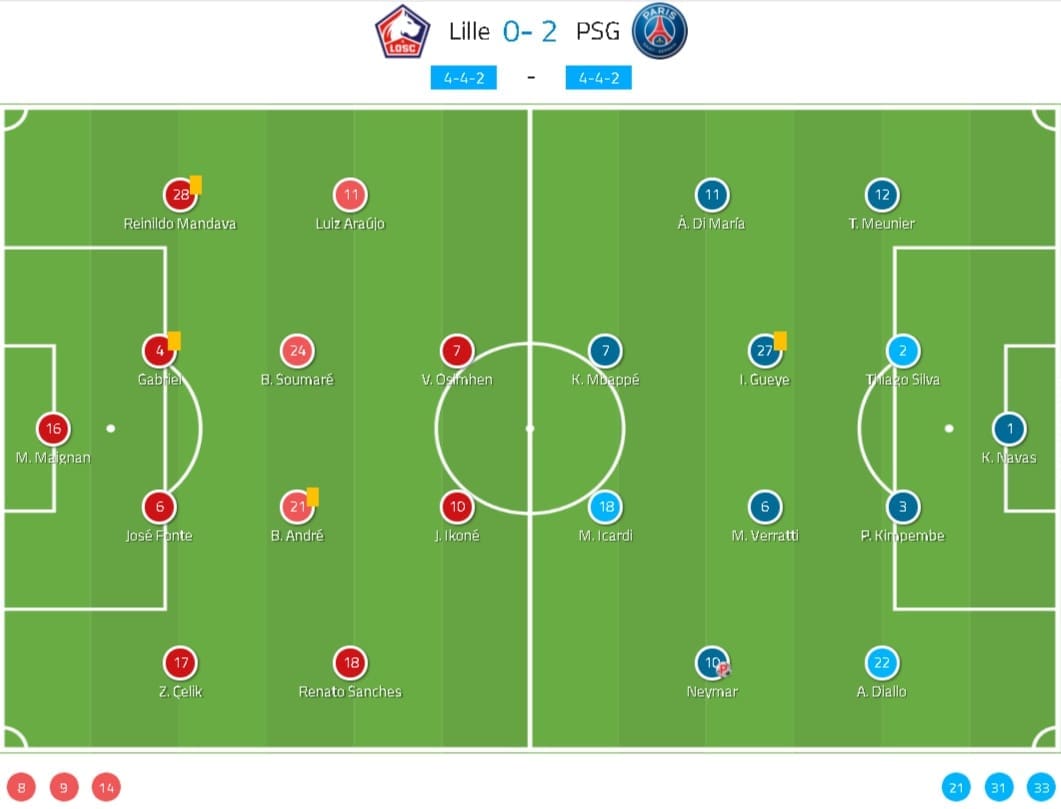
As usual, Galtier used his favoured 4-4-2 system in this game. Tactically, Galtier didn’t seem to spring any surprises as Lille still stuck with their usual tactics in attack, defence, and transitions.
Not a lot of changes in personnel as well for Lille in this game. Mike Maignan and Zeki Çelik were back in the starting lineup, while Jonathan Bamba was replaced by Luiz Araújo.
Tuchel deployed his team also in a 4-4-2 system in this game. However, there were a lot of differences in terms of playing style and clear different tactical approach and tendencies in the game when compared to Lille’s 4-4-2 despite their seemingly similar system.
Minimal changes can be seen in the starting lineup as well. Thiago Silva, Idrissa Gueye, and Mauro Icardi all came back to the starting 11. Meanwhile, Julian Draxler and Pablo Sarabia were relegated to the bench. Marquinhos was not in the squad on Sunday due to injury.
Lille’s predictable attacks
Lille aimed to be rather direct in this game though they didn’t necessarily rely mostly on long balls. They were very straightforward and vertical-oriented, rarely keeping the ball for too long and would try to progress forward very quickly.
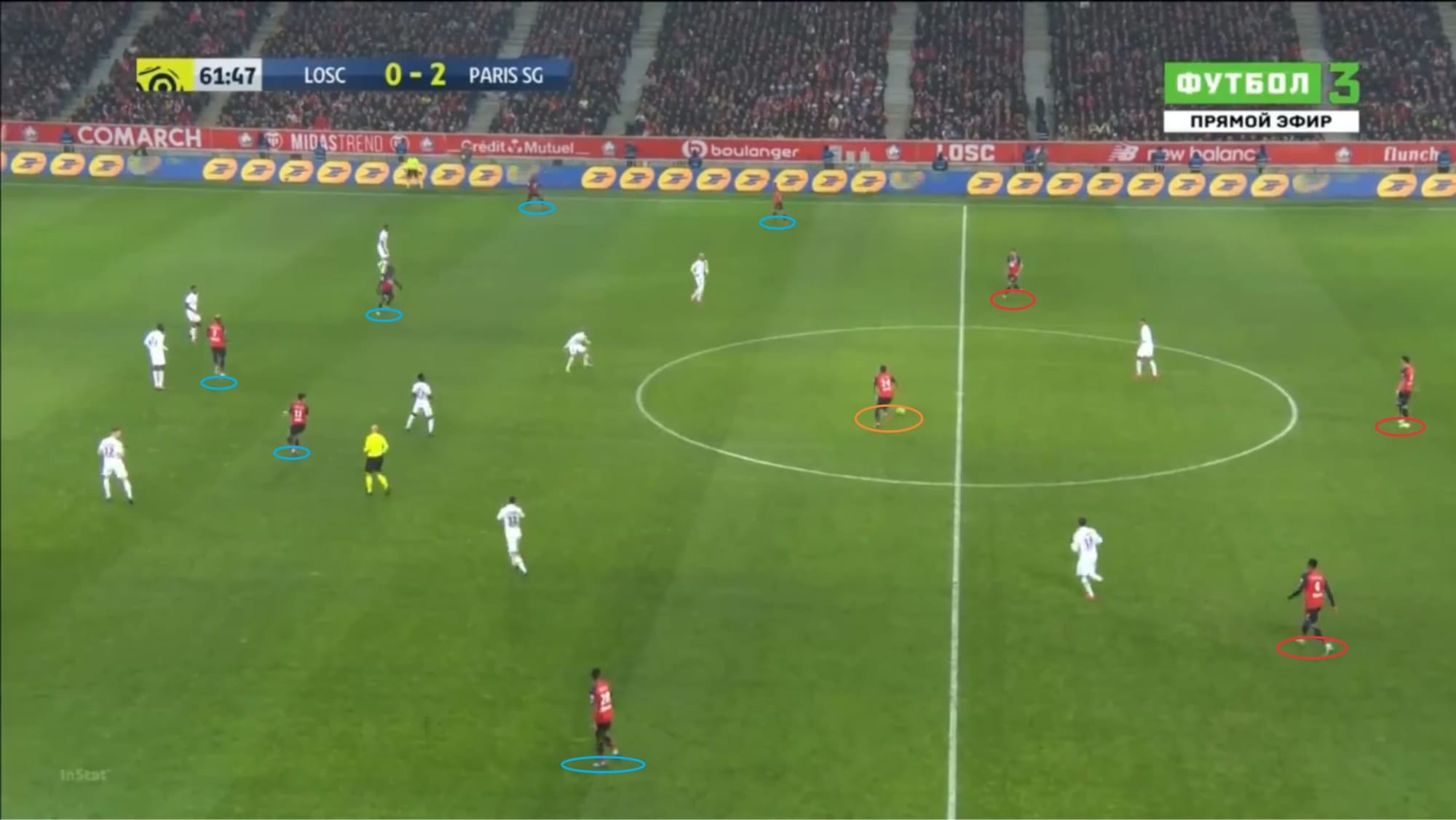
In the attacking phase, Lille would try to create a 3-1-6 shape right from the build-up.
Above you can see that Lille’s three at the back would outnumber PSG’s two men in their first line of pressure which allowed Lille to escape their frontline pressure easier. Boubakary Soumaré always sat centrally, playing the role of pivot as he always made himself available as the first pass in the midfield and looked to progress the ball forward.
Both full-backs sat quite high and near the touchline to provide width. Usually, both full-backs would remain in the middle third if they’re still in the early phase of build-up and would advance into the offensive third if the ball was already in an advanced position inside PSG’s half. To allow the full-backs some space to make an overlapping run, the wingers would move inside and sit narrower. In this particular picture above, although Renato Sanches can be seen occupying the same channel as Çelik, he would soon move into the right half-space and allow Çelik to occupy the right flank.
They have a different tendency when creating this 3-1-6 shape in the first half and in the second half.
In the second half, as you can see in the picture above, Xeka (who was brought in in the second half) would drop and sit beside the two centre-backs. This would allow Çelik to move higher up. Once the ball was moved forward and Lille managed to penetrate PSG’s half, Xeka would then move up to support the midfield and help Soumaré rotate the ball.
However, in the first half, Çelik was the one who would stay back to create the three-man backline. Meanwhile, Benjamin André would move forward and occupy the right half-space while Sanches would stay wide. This didn’t happen with Lille’s left-back though as Reinildo Mandava tended to immediately sit high and wide right from the build-up.
With Paris Saint-Germain tending to overload the middle and press aggressively if the ball was moved inside their block in central areas, Lille were having difficulties breaking through centrally.
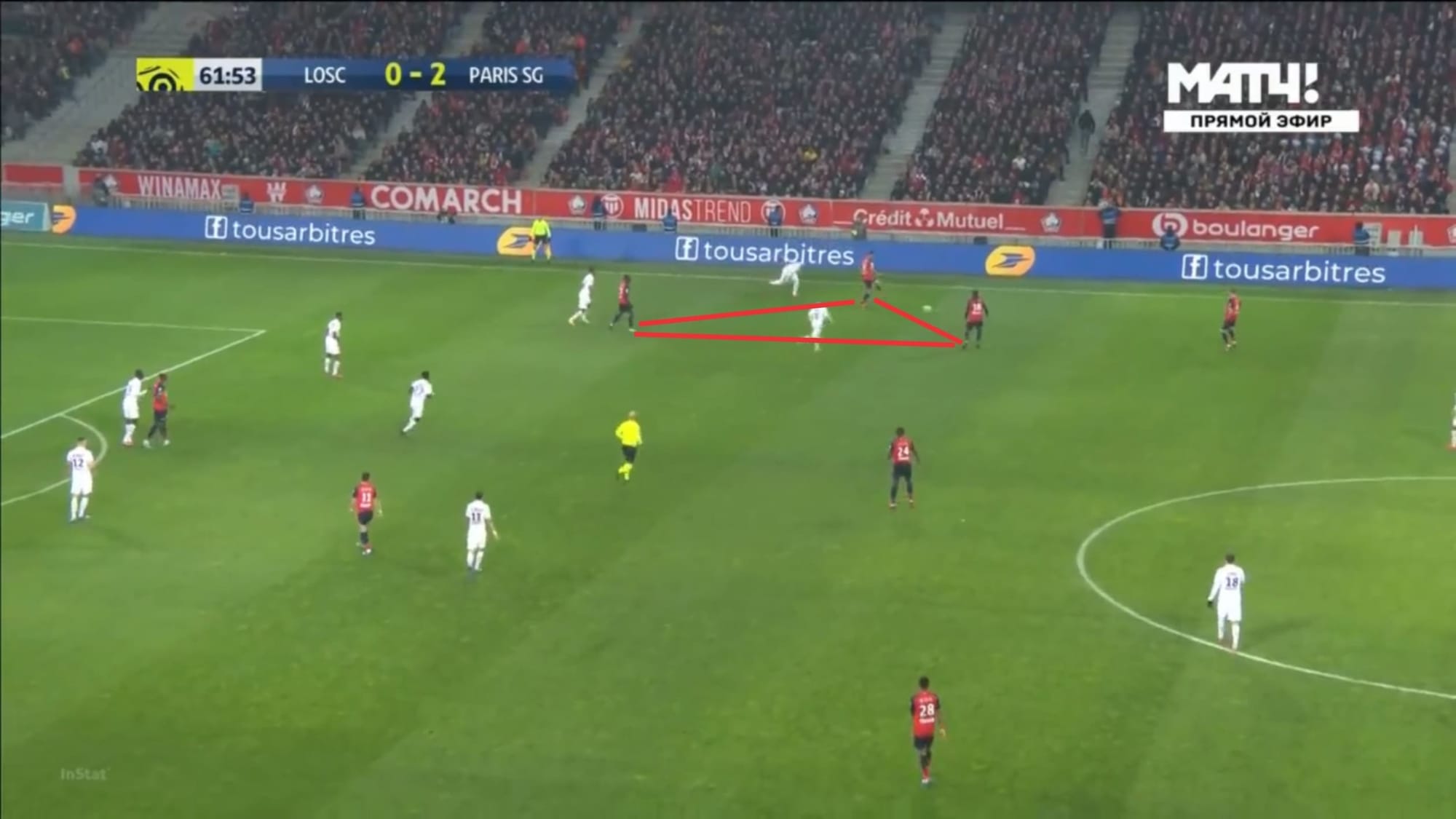
Lille would try to rotate the ball on the flank, creating passing triangles and using third-man runs to do so. Above you can see Jonathan Ikoné moving wider and sitting in the half-space to offer passing option and help create this triangular shape.
PSG, however, would counter this by creating overloads on the flanks and trying to isolate the ball-carrier. One player would press the ball whilst the other marked the near options. In the picture above, however, Xeka managed to get himself free from any marker and Lille successfully escaped PSG’s pressing trap and isolation.
Last season Lille were feared due to their dynamism in attacks. Using the same, 4-4-2/4-2-3-1 system, the four players upfront were very fluid and flexible and links with each other very well. However, since last season it was quite clear that they’re relying a bit much on the right flank in attacking phase.
This season, it was even clearer that they’re relying a bit too much on the right side of the pitch to cause danger.
Statistically, in this match they registered 41 attacks from the right flank, 26 from the middle, and only 17 from the left which was quite a contrasting number.
PSG’s rather vulnerable high press
Although there may be some little tweaks occasionally, PSG rarely changed their defensive tactics – especially in domestic competitions. Again, against Lille, PSG defended with a high block with a high defensive line and pressed high up the pitch.
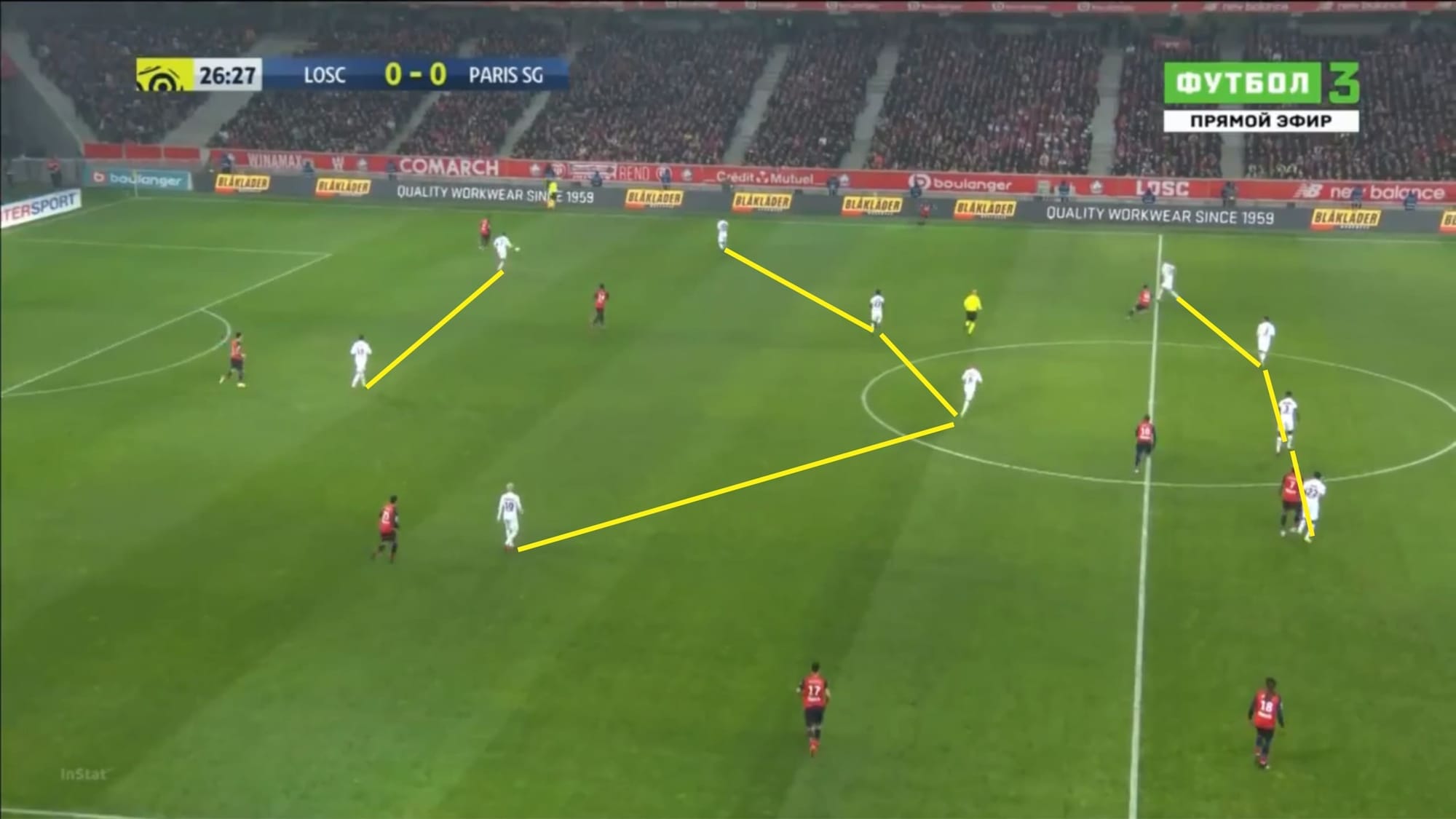
Above you can see PSG’s 4-4-2 structure in defence. PSG maintained moderate width in defence, especially their second line. With their defensive line sitting high, PSG were able to keep their second and third line compact and compress space in the middle third whilst also pressing Lille high up the pitch in an attempt to win the ball back in an advanced position.
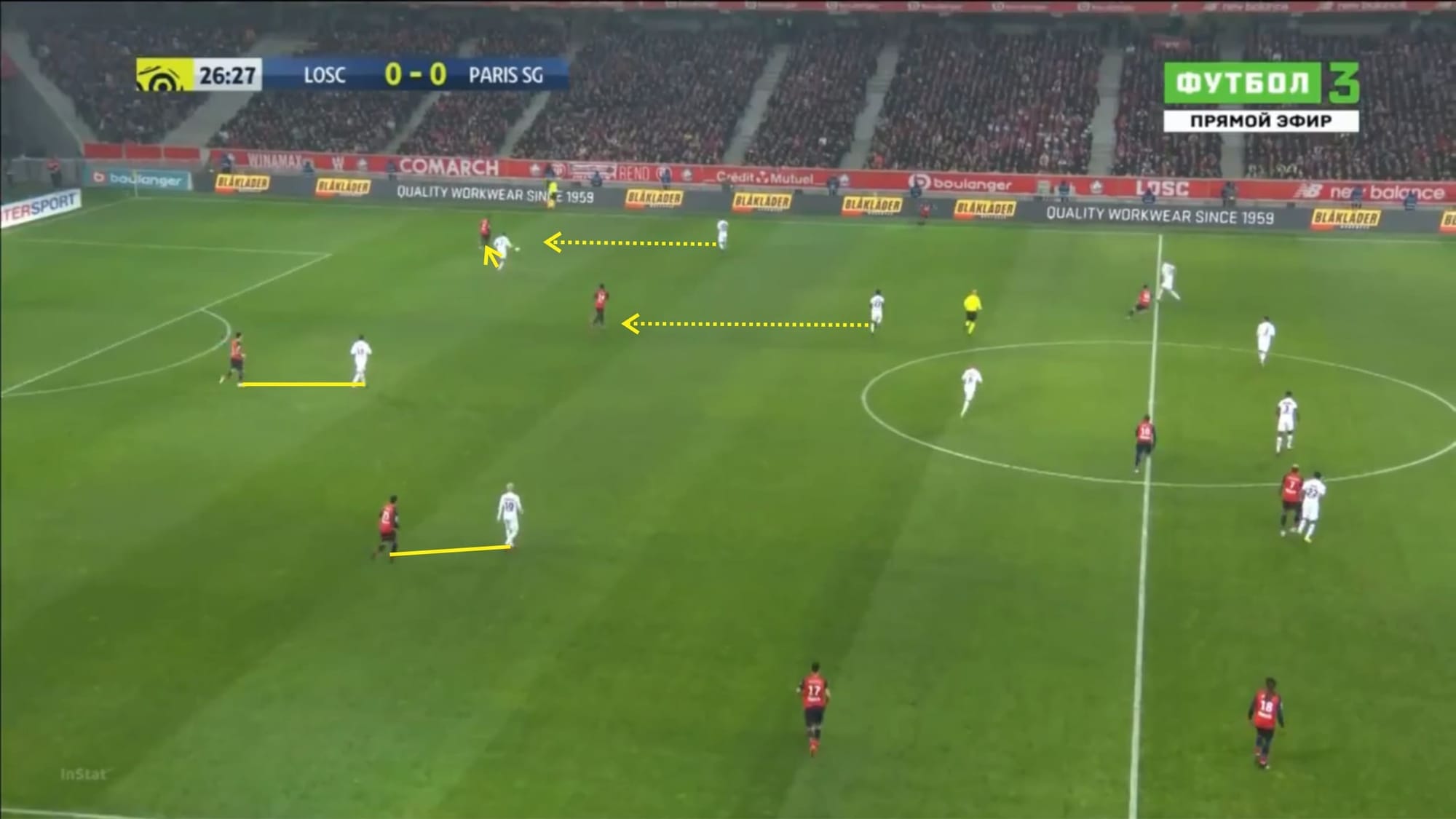
As you can see in the picture above, PSG’s first line looked to press the ball-carrier and steer him to move wider by closing down from his side. Icardi’s body positioning also allowed him to use his cover shadow to block the passing lane towards Soumaré. Once the ball-carrier was moved wider and separated from his teammates, PSG would trigger their pressing trap. Above you can also see Ángel Di María leaving his man (Reinildo) and pressed Gabriel Magalhães who was already isolated.
PSG’s defensive tactics seemed to be a combination of zonal and man coverage. As you can see the two pressers (Icardi and Di María) were both closing down the ball-carrier whilst also blocking the passing lane towards the pivot and full-back respectively. Gueye, meanwhile was defending the zone near the pivot. If Gabriel showed body signs of wanting to play the ball to the pivot, Gueye would move to close down the pivot. As you can see, Kylian Mbappé and Neymar each took a man to mark.
PSG’s backline, however, were largely man-to-man in defence but they could be flexible in marking.
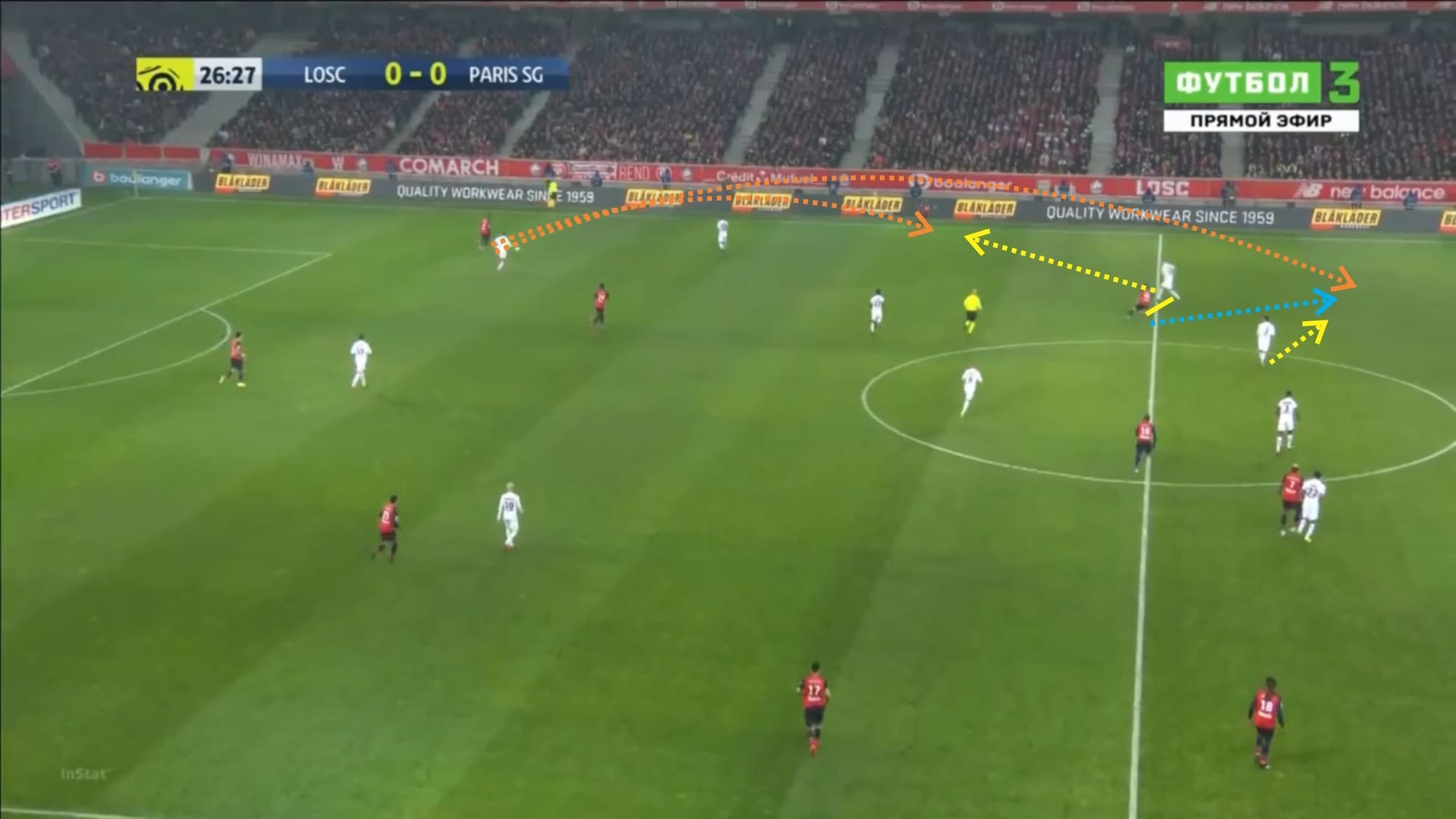
However, PSG’s pressing trap could be vulnerable at times. Above, for example, despite being pressed by Icardi and Di María, Gabriel still had several options to play the ball to. With Di María not closing down quick enough, Gabriel had the chance to chip the ball over him towards Reinildo which could then immediately create a 2v1 situation against PSG’s right-back on the wing.
However, Gabriel opted to pick out Araújo with a long ball into the back of the defence after the Brazilian made a nice off the ball movement and created space for himself. PSG’s situational marking would mean that Meunier had to pay attention to both Reinildo and Araújo when PSG triggered their pressing trap. In this particular situation in the picture, Gabriel looked as if he was looking to pass the ball towards Reinildo so Meunier decided to step out and anticipate the pass. Araújo spotted this and immediately made a run behind his back. However, Silva managed to read the situation cover Meunier’s spot in this situation.
This high press by PSG usually would cause produce several reactions from the opposition: backpass towards the goalkeeper (where PSG would then push forward in numbers and pile more pressure) or long pass forward (where PSG would try to win the first and second ball with their compact second and third line) or the ball-carrier would try to dribble out of pressure himself which is highly risky.
Their high press could be a nuisance, especially for teams who play out from the back, but once quick, smart, and well-timed breaks could really hurt them. Lille, however, were often not quick enough in attacking transitions and a bit too clumsy when launching their forward passes.
Fluid attack of PSG was a nightmare for Lille’s man-marking defence
PSG’s main idea and tactical tendencies in attack were largely the same as in their previous matches.
As usual, they were patient and possession-based in the build-up and tended to mostly use short passes as they progress forward and work the ball into the box. PSG always looked to progress through the middle and attack centrally whenever possible, although in this game, Lille’s compact and narrow mid-block as well as pressing trap and overload in the middle would make it very hard for them to do so.
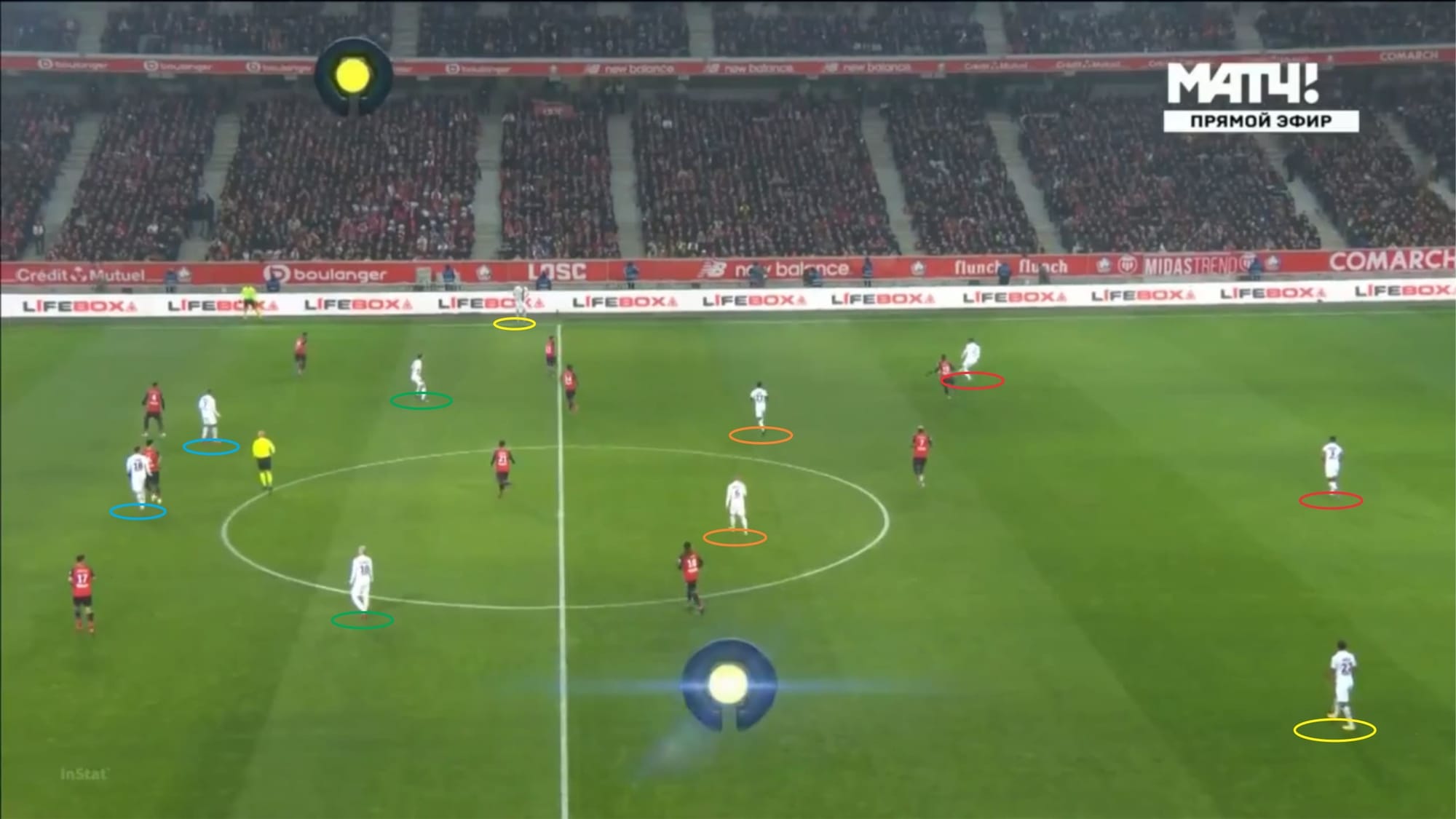
In the build-up PSG looked to create a 2-4-4 shape although in this picture the shape looked asymmetrical due to Abdou Diallo’s tendency to stay deep in the early phase of attack and would only move forward when the ball was in an advanced area. Meunier, meanwhile, were much more offensive-minded and would immediately sit high and wide in the build-up.
Both Marco Verratti and Gueye stayed in the six spaces, however, access to both of these players were often quite difficult as they were both man-marked and the first line of Lille would also try to block the passing lane towards either man. This would force PSG to play the ball wide towards the full-back. Rather than hugging the touchline, the full-back would usually pass the ball towards the winger who was sitting in a pocket of space in the half-space and PSG would then penetrate central areas from there.
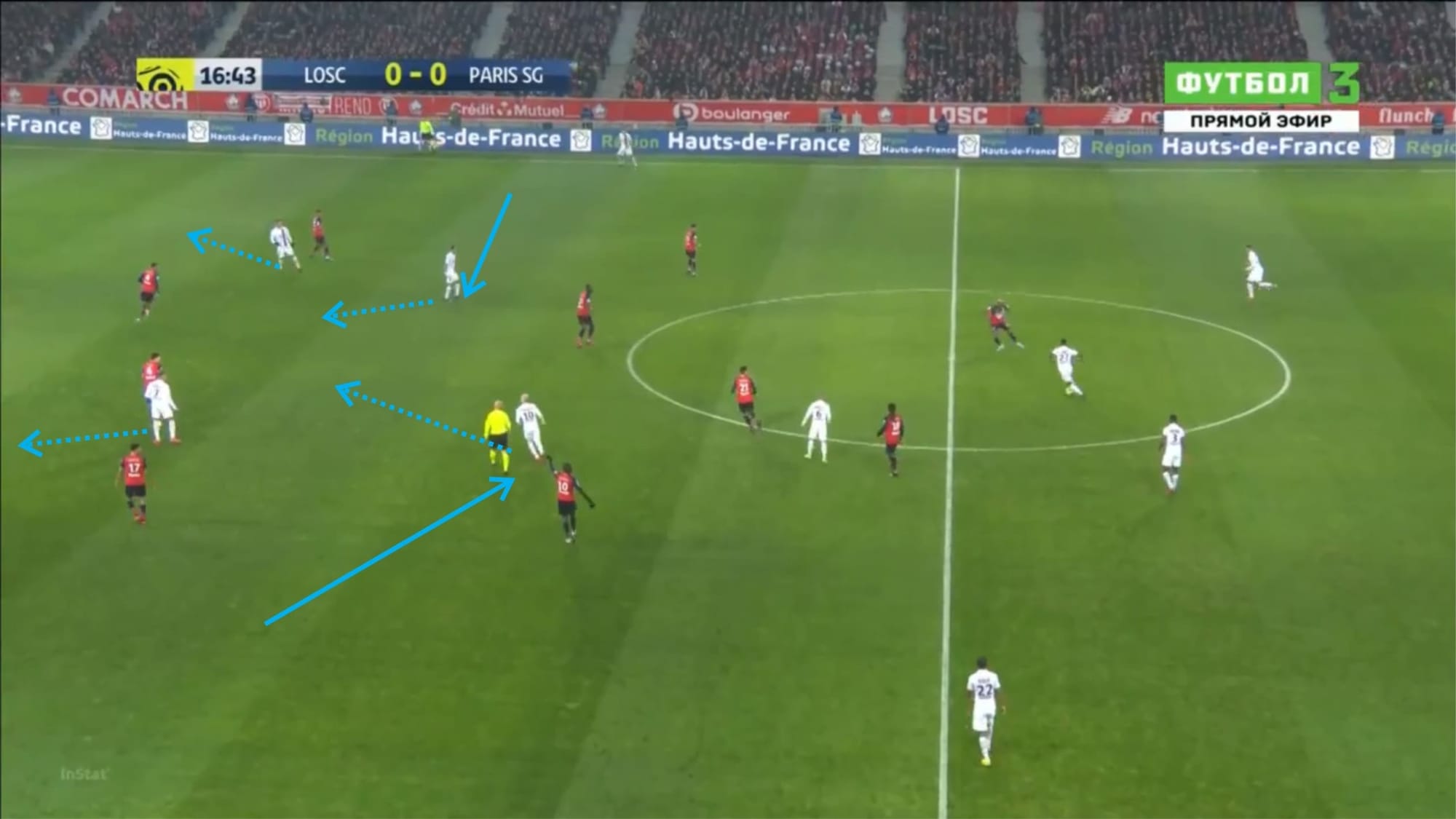
PSG’s four-man attack were very flexible. All four players upfront would constantly swap positions and flexibly roam around. Neymar and Di María tended to float around the space between the second and third line of Lille in the half-space. Both Neymar and Di María then would often occupy central areas while Mbappé and Icardi moved wider.
As you can see in the picture above, Mbappé and Icardi both occupied two defenders each, allowing Neymar and Di María a bit more freedom in the space between the two lines. The narrow positioning of the winger meant that PSG would be able to create attacking overloads in the middle, helping them to escape Lille’s tight defence and aggressive pressure and attack centrally.
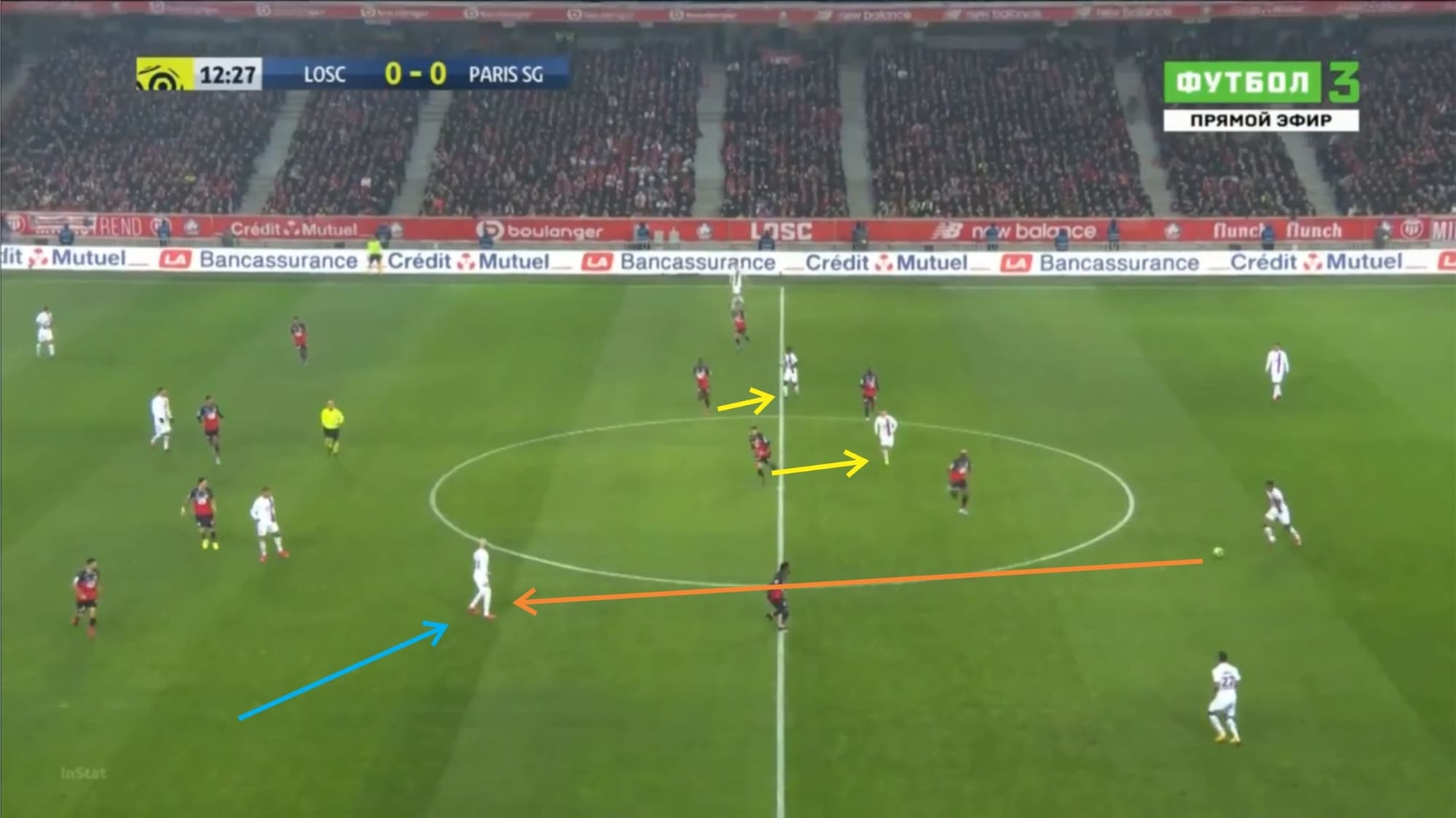
At times, Lille man-oriented marking could also be exploited by PSG.
Above, for example, the ball was played to one of the two PSG pivots but then returned back to the centre-back (Presnel Kimpembe) which explains why Lille’s second and first line were very tight (Lille would compress space and press if the ball was played inside their block in central areas). This opened up a huge space for Neymar who, as mentioned before in this tactical analysis, would float around in the space between the second and third line.
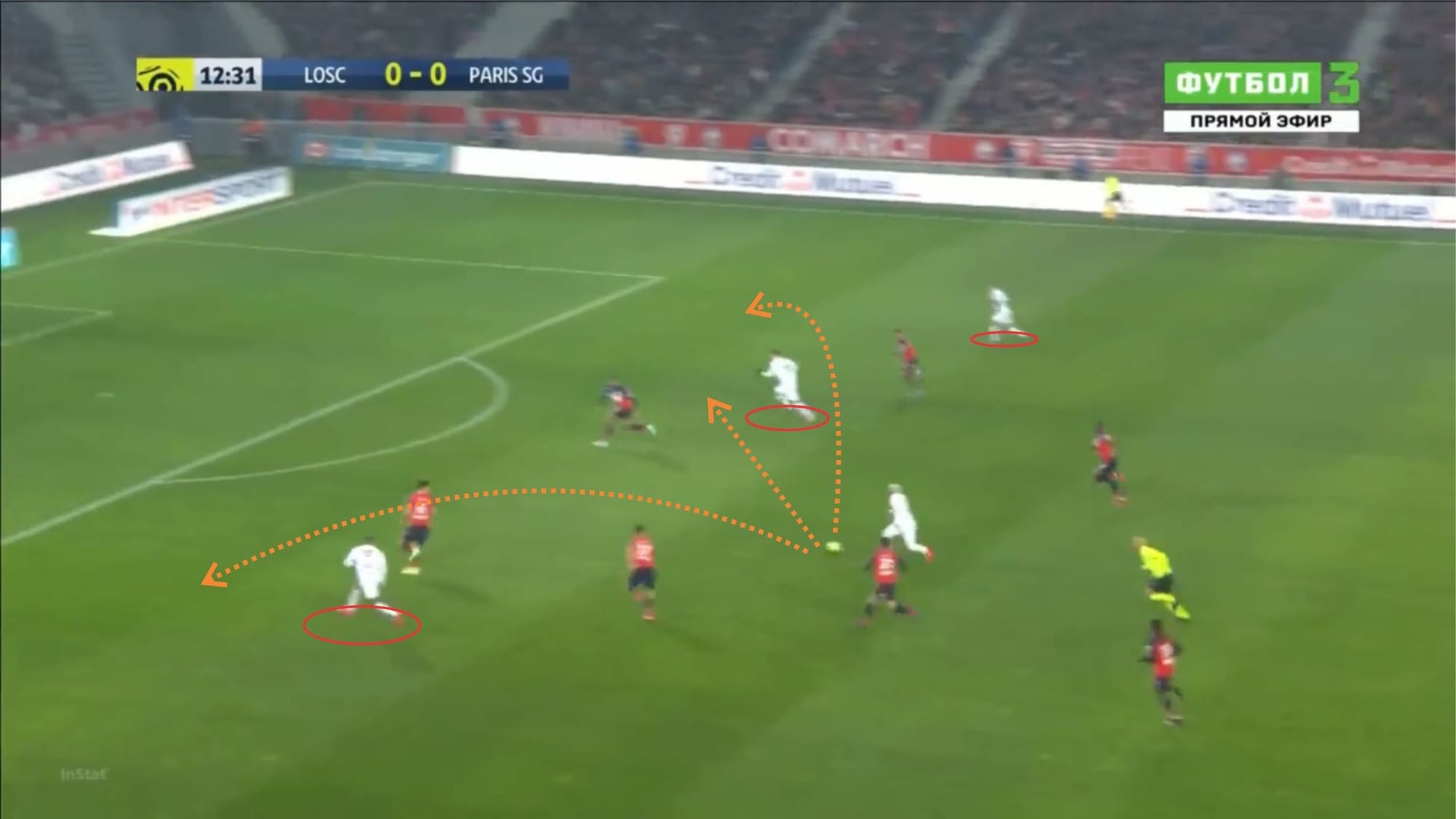
Upon receiving the ball, Neymar quickly turned and burst forward. Kimpembe’s pass to Neymar and the Brazilian’s quick turn immediately created a 4v4 situation at the back and now Neymar had several options to pick out. He could pass the ball towards either of the three players in front of him or he can drive forward and took a shot himself. Neymar did pick out Di María in the end but Lille ultimately managed to clear the danger.
Conclusion
PSG were very effective in attack in this game. Despite dominating possession, PSG weren’t able to penetrate the box a lot but despite Lille’s persistence in defence, Neymar and co. still managed to work the ball into the box and create some dangerous chances for themselves. PSG could have scored more were it not for the brilliance of Maignan.
Lille, on the other hand, managed to exploit PSG’s rather vulnerable defence and get into advanced positions often but failed to take any of their chances. Their attacks were also a bit too predictable, meaning that PSG managed to neutralise them before they managed to create any danger.
Tuchel’s side are currently untouchable at the top of the league table with 52 points from 21 games. Lille, meanwhile, would look to sort themselves out as they have now lost three games in a row.




Comments